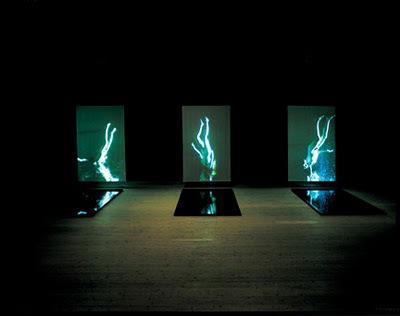WATER – IN ITS VAST eternity – reaches the infinite within us, connecting the single entity into a whole. One drop within a body of water expands to the entirety of the sea; birth, flooding, drowning. Life and death are held within the liquid mass of water, and can deliver us back to the beginning of it all. Through water, we are held within ourselves, and we project our own image onto it. We find ourselves seduced by the sub-conscious dream, only here does our body allow us to meditate on our void; shifting attention from the outside world and creating a space for healing, transformation and rebirth. The immersive qualities of the earthly elements embody and saturate us wholly.
‘The external spectacle helps intimate grandeur unfold’1 wrote the philosopher Gaston Bachelard. To take notice of our perceptions, let them rush in, blow over us, is a post-modern ritual, replacing ancient and religious modes of delivery: cleansing and healing. In consuming a spectacle, our senses are engaged. In this experience, we project our image, suspending it in space, meditating on our own void. In search of answers, we turn to spectacles that captivate our senses: art, theatre, fashion and cinema.


‘Like the sea, it reveals the depths of being within us.’
– Philippe Diolé2


‘When the waters rise, humanity will go back to the place from whence it came. “but then again, I’m no Nostradamus…”’
– Alexander McQueen3
‘Every time I view the sea, I feel a calming sense of security, as if visiting my ancestral home; I embark on a voyage of seeing.’
– Hiroshi Sugimoto4

‘Why is the spectacle of the sea so infinitely and eternally agreeable? Because the sea presents at once the idea of immensity and movement.’
– Charles Baudelaire5


Anna Ellinor Sundström is a photographer, filmmaker and founder of VNIVRS.
G Bachelard, The Poetics of Space, Beacon Press, Boston, 1994, p. 182. ↩
P Diolé, The Most Beautiful Desert of All, Jonathan Cape, London, 1959, p. 14 ↩
http://www.alexandermcqueen.com/experience/en/alexandermcqueen/archive/?years=2010#id_article=260 ↩
http://www.sugimotohiroshi.com/seascape.html ↩
C Baudelaire, Intimate Journals, Dover Publications, New York, 2006, p. 90 ↩

